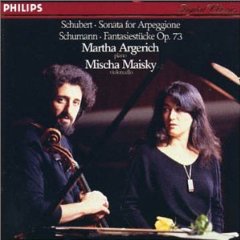Franz Schubert - Sonata Arpeggione (Argerich, Maisky) [1984]
Franz Schubert - Sonata Arpeggione (Argerich, Maisky) [1984]

1) 1. Allegro moderato (11:57) 2) 2. Adagio (4:35) 3) 3. Allegretto (9:24) Martha Argerich, Piano Mischa Maisky, Cello
The guitarre d'amour, or arpeggione as it came to be known, was invented sometime during 1823 or 1824 by the respected Viennese guitar maker Johann Georg Stauffer. The instrument -- a kind of enlarged guitar that could be bowed, cello-style, due to an altered fingerboard -- was by no means a success; within just a few years of its birth it had for all intents and purposes suffered extinction. To music lovers, however, this short-lived instrumental curiosity will be forever remembered as the vehicle for Franz Schubert's Sonata "per arpeggione" in A minor, D. 821 -- a work now played almost exclusively by violists and cellists, although it exists in arrangements for instruments as far afield as the euphonium.
Schubert composed the "Arpeggione" Sonata in November 1824 shortly after returning from Zseliz, where he had spent his second summer (the first one being in 1818) teaching music to the Count of Esterházy's two daughters. The three-movement Sonata must be altered somewhat if it is to be played on cello or viola: the arpeggione possessed six strings, tuned to the same pitches as a guitar's, and the resulting extended range can cause problems when the piece is transcribed; in most editions, certain portions of the piece are transposed up or down an octave from their original position to avoid the extreme registers. However, Schubert by and large avoided the kind of idiosyncratic arpeggiations that earned the original instrument its nickname, focusing instead on the same focused lyricism that drives a traditional sonata for string instrument and piano; in this way, the work readily adapts to modern performance.
The opening Allegro moderato is built around a wistful melody whose fame is such that many who have never heard or heard of the "Arpeggione" Sonata will find that they recognize the tune. A second theme proceeds in gentle gusts of sixteenth notes; the arpeggione could not play fast notes with much volume at all, and so the Sonata's quicker portions are almost always marked piano or pianissimo.
The Adagio is a rich but introverted musing on an almost hymn-like subject. Schubert places great emphasis on the Neapolitan chord -- a harmony also used to great effect in the opening movement -- during the movement's closing measures, weakening the power of the final cadence and thus inviting the soloist to improvise a brief transition into the final, multi-sectioned Allegretto. ---Blair Johnston, Rovi
download: uploaded yandex 4shared mediafire solidfiles gett mega zalivalka filecloudio anonfiles oboom
Last Updated (Sunday, 27 April 2014 12:17)








